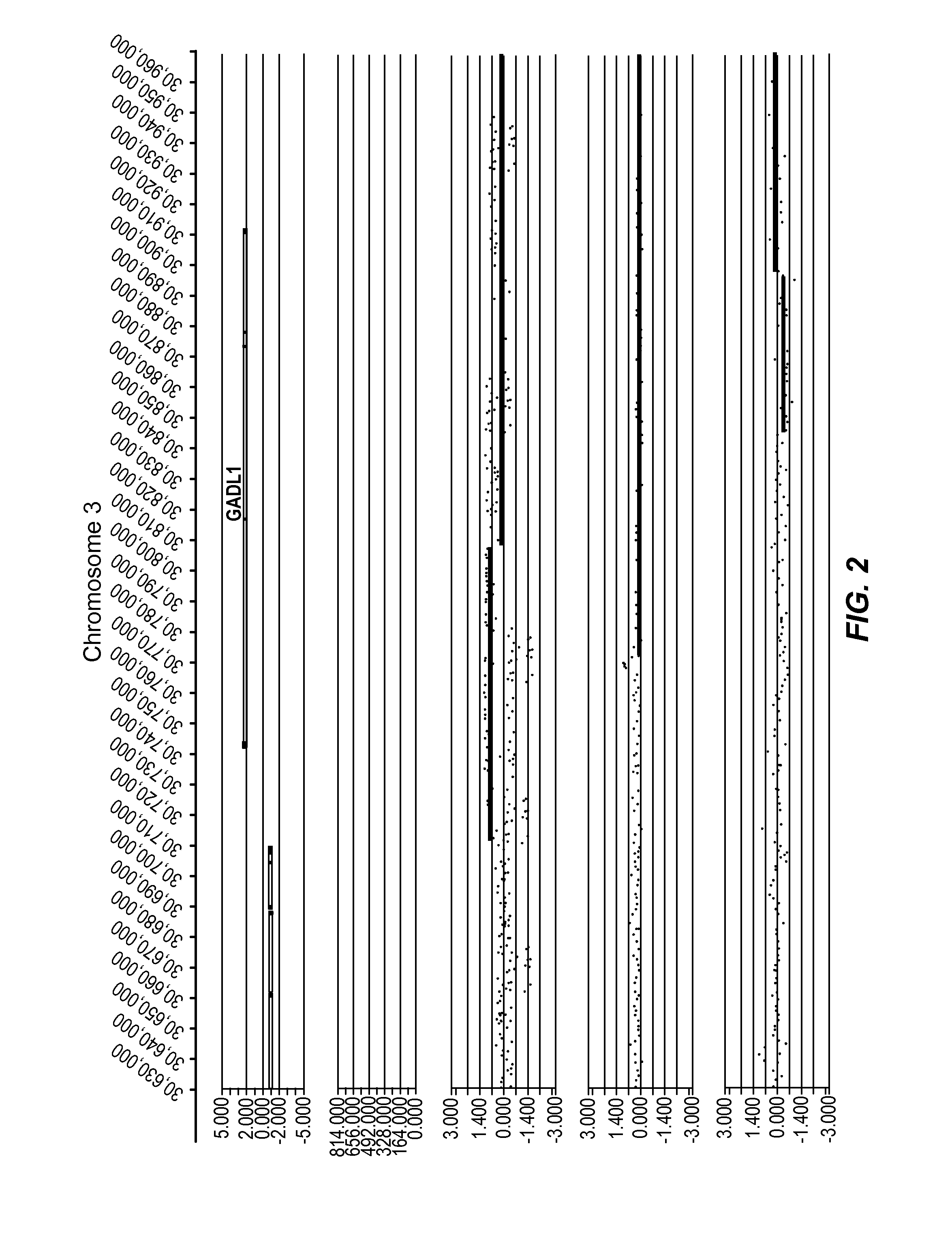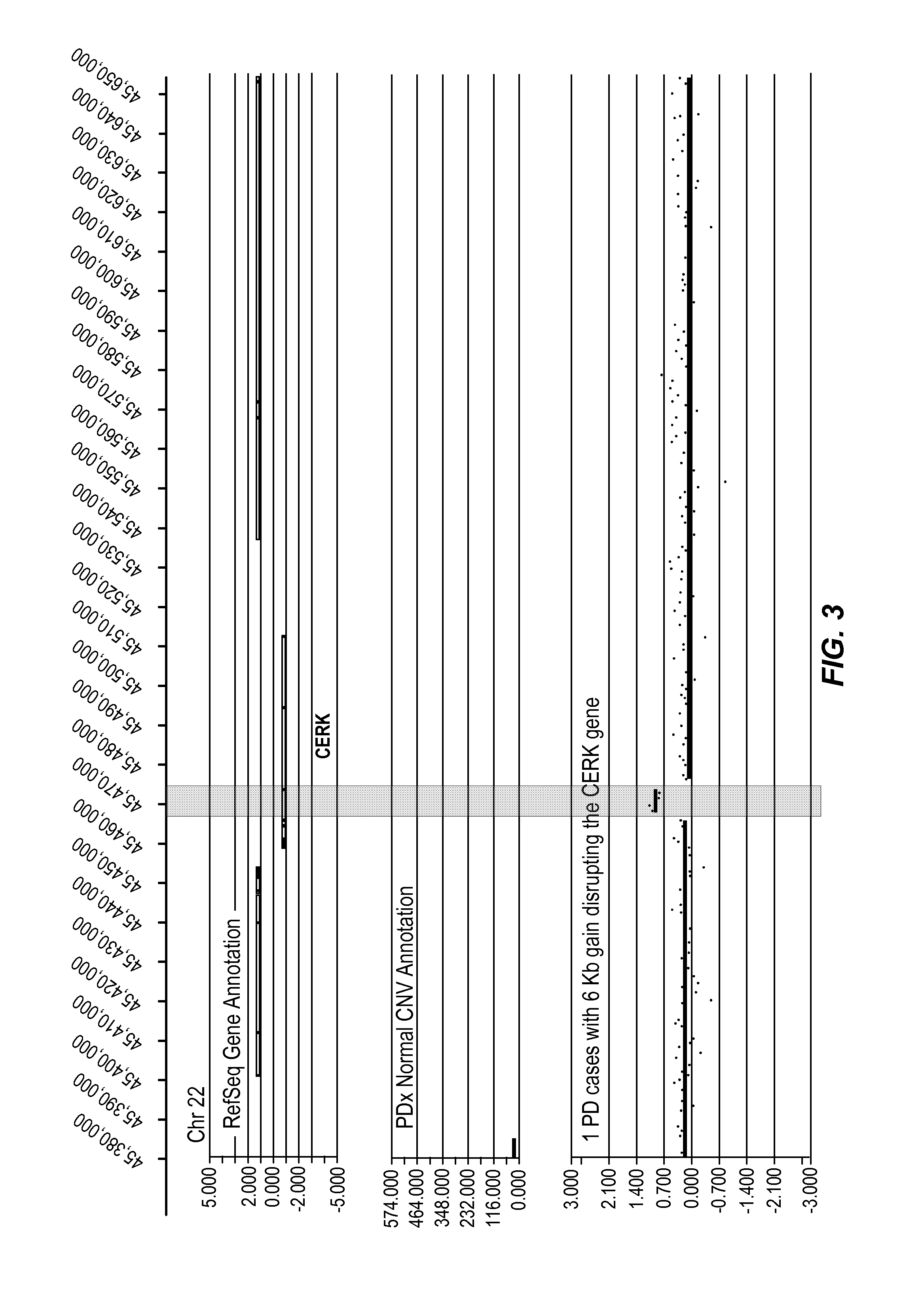Methods and compositions for diagnosing, prognosing, and treating neurological conditions
a neurological condition and composition technology, applied in the field of neurological conditions diagnosis, prognosis, and composition, can solve the problems of large fraction of the genetic contribution to these disorders, such as pd, and the rareness of the majority of these variants, and achieve the effect of reducing the susceptibility to nd
- Summary
- Abstract
- Description
- Claims
- Application Information
AI Technical Summary
Benefits of technology
Problems solved by technology
Method used
Image
Examples
example 1
[0378]In the present study, data was generated on the basis of a comparison of copy number variants (CNVs) identified in 2 cohorts:
1. 1,005 Normal individuals (Normal Variation Engine—NVE);
2. 468 Parkinson's Disease (PD) cases (samples obtained from the The Parkinson's Institute and Clinical Center (PI), Sunnyvale, Calif. 94085, USA).
[0379]Genomic DNA samples from individuals within the Normal cohort (NVE ‘test’ subjects) and from the PD cohort (PD ‘test’ subjects) were hybridized against a single, sex-matched reference individual as follows. Reference DNA samples were labeled with Cy5 and test subject DNA samples were labeled with Cy3. After labeling, samples were combined and co-hybridized to Agilent 1M feature oligonucleotide microarrays, design ID 021529 (Agilent Product Number G4447A) using standard conditions (array Comparative Genomic Hybridization—aCGH). Post-hybridization, arrays were scanned at 2 μm resolution, using Agilent's DNA microarray scanner, generating tiff images...
example 2
[0391]The study also included of a comparison of copy number variants (CNVs) identified in 2 cohorts: 1,005 Normal individuals (Normal Variation Engine−NVE) and 87 PD cases (DNA samples obtained from Coriell Institute).
[0392]Genomic DNA samples from individuals within the Normal and the PD cohorts (‘test’ subjects) were hybridized against a single, sex-matched reference individual as follows. Reference DNA samples were labeled with Cy5 and Test subject DNA samples were labeled with Cy3. After labeling, samples were combined and co-hybridized to Agilent 1M feature oligonucleotide microarrays, design ID 021529 (Agilent Product Number G4447A) using standard conditions (array Comparative Genomic Hybridization—aCGH). Post-hybridization, arrays were scanned at 2 μm resolution, using Agilent's DNA microarray scanner, generating tiff images for later analysis. Tiff images were analyzed using Agilent Feature Extraction (FE) software, with the following settings:
Human Genome Freeze:hg18:NCBI3...
example 3
[0404]FIG. 1 is an example of a copy number gain occurring in three PD cases that disrupts a gene wherein a CNV-subregion overlaps a known gene, and is associated with an OR of at least 6.
[0405]FIG. 1 represents an example of a CNV-subregion that overlaps a known gene, and is associated with an OR of at least 6. The CNV is a gain (log 2 ratio>0.35) and affects the gene MGAT4C on chromosome 12. The calculated odds ratio (OR) for this CNV-subregion is 6.48.
[0406]In the figure, five tracks of information are shown, from top to bottom: 1) RefSeq gene annotation showing the genome location α-axis) of genes demarcated in light gray (introns) and dark gray (exons) and with multiple entries depicted if multiple transcript variants are annotated that correspond to the gene; 2) size and genome location α-axis) for normal CNVs annotated for greater than 1,000 unaffected / normal individuals, with CNVs demarcated by dark gray bars and the y-axis corresponds to the number of individuals in the nor...
PUM
| Property | Measurement | Unit |
|---|---|---|
| disorder | aaaaa | aaaaa |
| movement | aaaaa | aaaaa |
| Northern blot | aaaaa | aaaaa |
Abstract
Description
Claims
Application Information
 Login to View More
Login to View More - R&D
- Intellectual Property
- Life Sciences
- Materials
- Tech Scout
- Unparalleled Data Quality
- Higher Quality Content
- 60% Fewer Hallucinations
Browse by: Latest US Patents, China's latest patents, Technical Efficacy Thesaurus, Application Domain, Technology Topic, Popular Technical Reports.
© 2025 PatSnap. All rights reserved.Legal|Privacy policy|Modern Slavery Act Transparency Statement|Sitemap|About US| Contact US: help@patsnap.com



